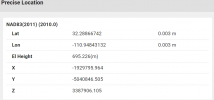So I took a mapping class and though I’m able to go out and map a piece of land, they did a really poor job of showing how RTK is actually implemented.
Watching dozens of videos hasn’t cleared up any thing.
1. With a base station do I still need a known surveyed point? I assume then the station gets mounted directly on this point.
2. When do I use gcps? Are there gcps already in place that eliminate the need to use a base station?
3. Do I use the base station to enter the location of the gcps?
4. Once gcps are in place do I still use the base station in flight?
I need a good walkthrough on the whole process. Ideally I would shadow someone in the field. Sadly drones are not much in use here in the Los Angeles area.
Thanks and hope all are well.
Watching dozens of videos hasn’t cleared up any thing.
1. With a base station do I still need a known surveyed point? I assume then the station gets mounted directly on this point.
2. When do I use gcps? Are there gcps already in place that eliminate the need to use a base station?
3. Do I use the base station to enter the location of the gcps?
4. Once gcps are in place do I still use the base station in flight?
I need a good walkthrough on the whole process. Ideally I would shadow someone in the field. Sadly drones are not much in use here in the Los Angeles area.
Thanks and hope all are well.
Last edited:














